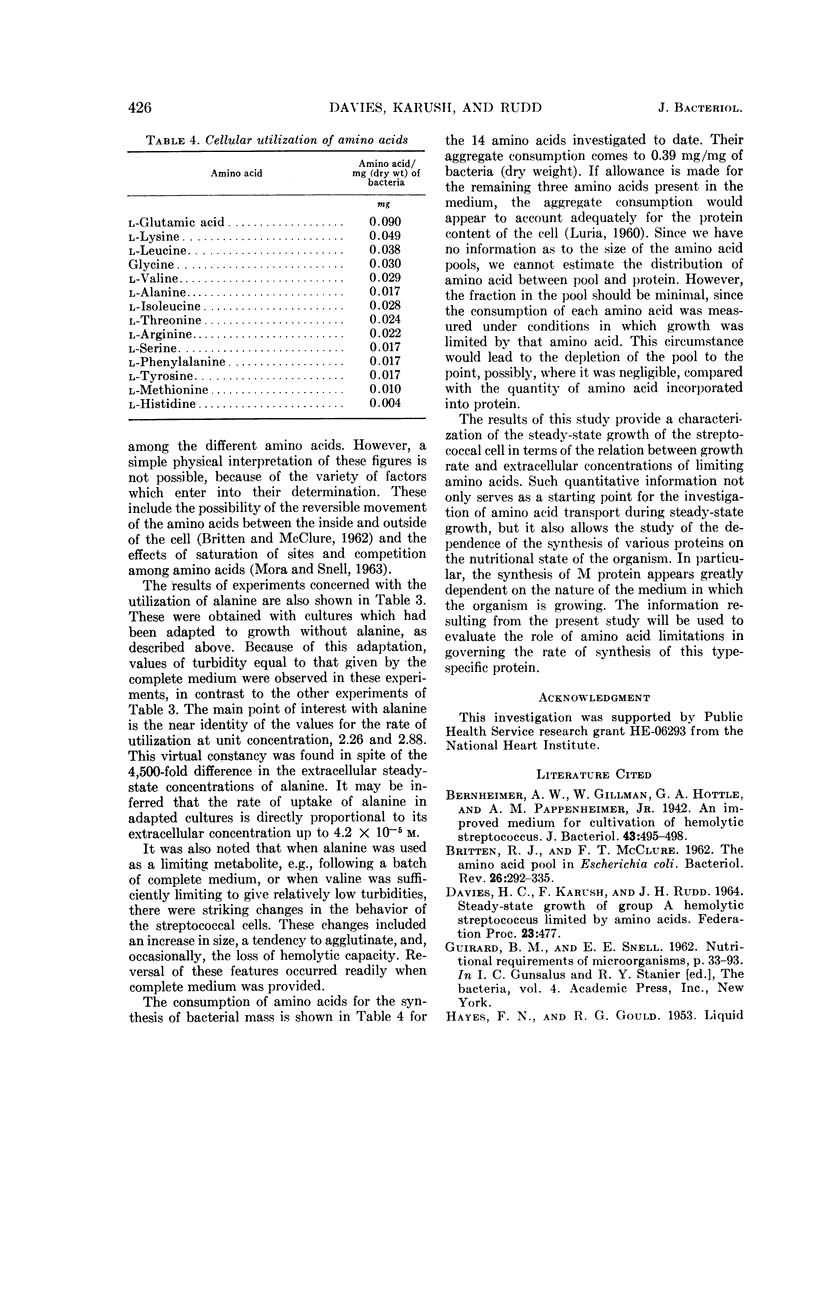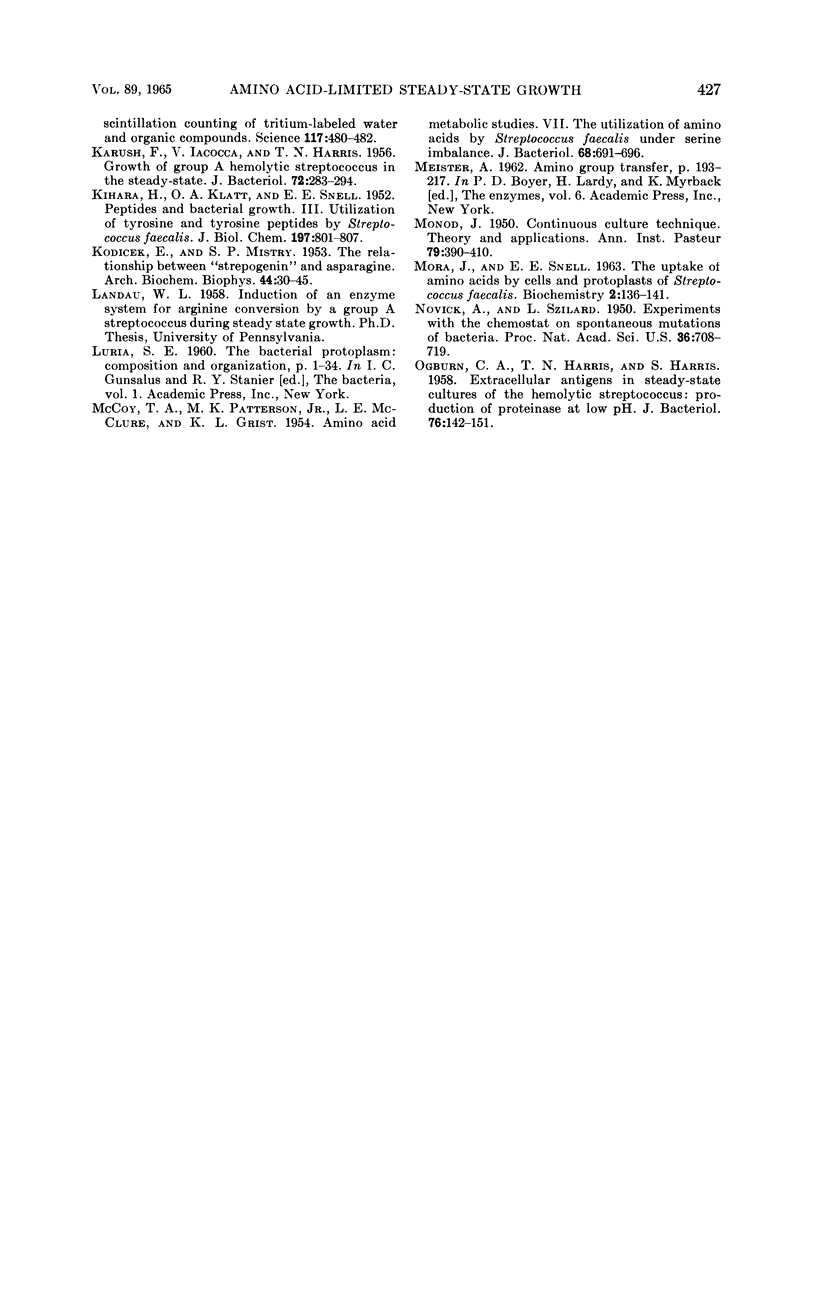Abstract
Davies, Helen C. (University of Pennsylvania, Philadelphia), Fred Karush, and Joanne H. Rudd. Effect of amino acids on steady-state growth of a group A hemolytic streptococcus. J. Bacteriol. 89:421–427. 1965.—A study has been made of amino acid utilization by a strain of type 4, group A streptococcus growing under steady-state conditions in a continuous-culture device and supplied with a completely synthetic medium. At a fixed growth rate, corresponding to a generation of time of 84 min, and with the pH maintained constant at 7.4, the bacterial turbidity was made dependent on the concentration of one of the amino acids of the defined medium. Under these conditions, the extracellular concentration of the limiting amino acid is fixed by the preset growth rate. The steady-state concentration of each of 14 essential l-amino acids was measured by means of C14-labeled amino acids in such limited cultures. At approximately equal turbidities, these concentrations ranged from 1.6 × 10−6m for methionine to 4.3 × 10−4m for glutamic acid. The rates of utilization of the amino acids ranged from 26 mμmoles per mg (dry weight) of bacteria per hr for histidine to 310 mμmoles per mg (dry weight) of bacteria per hr for glutamic acid. The percentage of the limiting amino acid used varied from 95% for threonine and methionine to 43% for gluamic acid. The rate of utilization of the limiting amino acid at unit concentration (tmoles per gram per hour per m) differed by a factor of 27 between extremes. These observations reflect the variation in the capacity of this streptococcal cell to take up and use different amino acids.
Full text
PDF






Selected References
These references are in PubMed. This may not be the complete list of references from this article.
- BRITTEN R. J., McCLURE F. T. The amino acid pool in Escherichia coli. Bacteriol Rev. 1962 Sep;26:292–335. doi: 10.1128/br.26.3.292-335.1962. [DOI] [PMC free article] [PubMed] [Google Scholar]
- Bernheimer A. W., Gillman W., Hottle G. A., Pappenheimer A. M. An Improved Medium for the Cultivation of Hemolytic Streptococcus. J Bacteriol. 1942 Apr;43(4):495–498. doi: 10.1128/jb.43.4.495-498.1942. [DOI] [PMC free article] [PubMed] [Google Scholar]
- HARRIS T. N., IACOCCA V. F., KARUSH F. Growth of group A hemolytic streptococcus in the steady state. J Bacteriol. 1956 Sep;72(3):283–294. doi: 10.1128/jb.72.3.283-294.1956. [DOI] [PMC free article] [PubMed] [Google Scholar]
- Hayes F. N., Gould R. G. Liquid Scintillation Counting of Tritium-labeled Water and Organic Compounds. Science. 1953 May 1;117(3044):480–482. doi: 10.1126/science.117.3044.480. [DOI] [PubMed] [Google Scholar]
- KIHARA H., KLATT O. A., SNELL E. E. Peptides and bacterial growth. III. Utilization of tyrosine and tyrosine peptides by Streptococcus faecalis. J Biol Chem. 1952 May;197(2):801–807. [PubMed] [Google Scholar]
- KODICEK E., MISTRY S. P. The relationship between strepogenin and asparagine. Arch Biochem Biophys. 1953 May;44(1):30–45. doi: 10.1016/0003-9861(53)90006-x. [DOI] [PubMed] [Google Scholar]
- McCOY T. A., PATTERSON M. K., Jr, McCLURE L. E., GRIST K. L. Amino acid metabolic studies. VII. The utilization of amino acids by Streptococcus faecalis under serine imbalance. J Bacteriol. 1954 Dec;68(6):691–696. doi: 10.1128/jb.68.6.691-696.1954. [DOI] [PMC free article] [PubMed] [Google Scholar]
- NOVICK A., SZILARD L. Experiments with the Chemostat on spontaneous mutations of bacteria. Proc Natl Acad Sci U S A. 1950 Dec;36(12):708–719. doi: 10.1073/pnas.36.12.708. [DOI] [PMC free article] [PubMed] [Google Scholar]
- OGBURN C. A., HARRIS T. N., HARRIS S. Extracellular antigens in steady-state cultures of the hemolytic Streptococcus: production of proteinase at low pH. J Bacteriol. 1958 Aug;76(2):142–151. doi: 10.1128/jb.76.2.142-151.1958. [DOI] [PMC free article] [PubMed] [Google Scholar]


